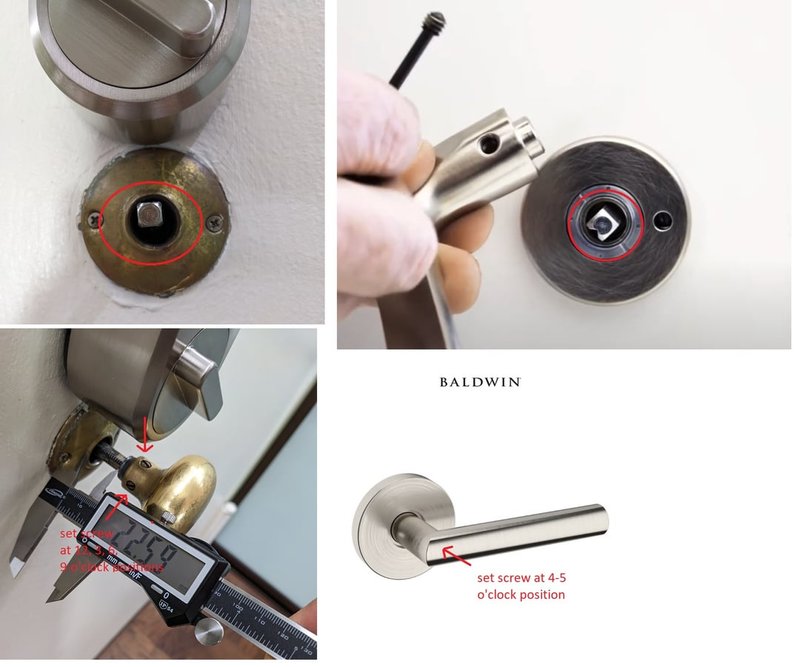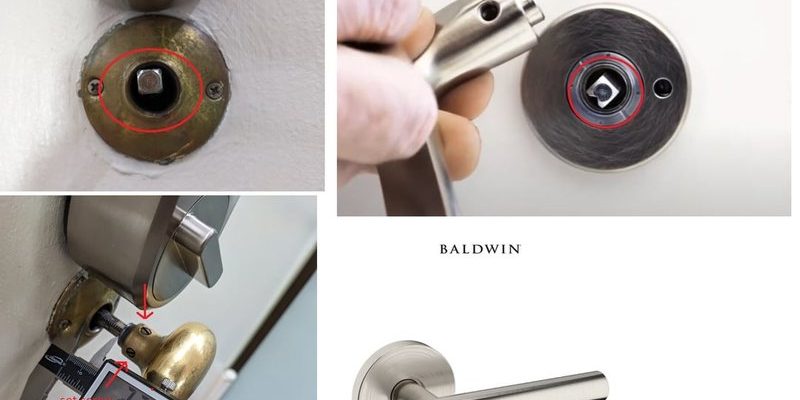
Let’s be honest: a door knob spindle with too much play is more than just a minor annoyance. It’s the kind of thing you notice every time you walk through the door, whether it’s a classic Schlage privacy set on a bedroom, or one of those old-school glass knobs you inherited with the house. And if you’re not quite sure what’s causing the problem or how to fix it, that’s totally normal. The good news? With a little troubleshooting, some basic tools, and a dash of patience, you can usually sort things out without calling for backup.
What Does “Too Much Play” in a Door Knob Spindle Mean?
When people talk about their door knob spindle having too much play, they’re usually describing that loose, shaky feeling when you turn the handle. Instead of a smooth and firm rotation, the knob wobbles side to side or shifts in and out. Sometimes, it even feels like the two sides of the knob are almost disconnected. Here’s the thing: the *spindle* is the metal rod that passes through the door, connecting both knobs and making the latch turn.
The spindle is essential because it’s literally the bridge between the two sides. When it’s working right, turning one knob rotates the spindle, which moves the latch. But when there’s too much play, it can feel like you’re cranking a stripped gear. Sometimes, the play is just a little bit—just enough to be annoying. Other times, it’s so bad the latch doesn’t retract properly and you’re stuck fumbling with the door.
If you notice the door knob turning more than usual before the latch moves, or you can wiggle the knob up and down (not just turn it), you almost certainly have too much play in the spindle.
Sometimes, this problem sneaks up gradually. One day it’s a tiny wobble, and weeks later you’re wondering if you’ll be able to get out of the room at all! If that sounds familiar, it’s time to dive in and see what’s really going on inside your door.
Why Does the Door Knob Spindle Develop Too Much Play?
You might be wondering why your door knob spindle has suddenly decided to go wobbly on you. The truth is, there’s usually more than one culprit. Over time, regular everyday use puts a surprising amount of strain on both the spindle and the knobs themselves.
- Normal wear and tear: Metal parts slowly grind away at each other. Years of turning the knob—especially if you have kids who use the door as a spinning toy—will eventually loosen things up.
- Loose set screws: These little screws hold the knob onto the spindle. If they work loose, even the sturdiest knob will start to wobble around.
- Worn or stripped spindle: The spindle itself can wear out, especially if it’s a cheap pot-metal version or not the right size for your knob.
- Poor installation or mismatched parts: Mixing brands (like pairing a Kwikset spindle with a Schlage knob) or forcing parts together can leave too much space, which means more play.
In some cases, the door shifting slightly with changes in temperature or humidity can also amplify the issue. Wood doors swell and shrink, and a once-tight spindle can loosen up as the door material flexes throughout the seasons.
How to Diagnose Where the Play Is Coming From
Let me explain the basics of troubleshooting this: before you can fix anything, you need to figure out exactly where the problem is. Not all door knob “play” comes from the same place, so it pays to be methodical.
Start by gently wiggling both knobs at the same time and see what moves. If just one knob feels wobbly while the other is solid, the problem is likely with the set screw on that side. But if the whole spindle seems to move independently of both knobs, the spindle itself may be worn or too short.
Next, take a close look at each set screw. These are usually located on the side of the knob closest to the door. If you see the screw sitting flush and tight, but the knob still moves, the spindle could be the issue. But if the screw looks loose or you can see a gap, tightening it may solve your problem immediately.
Pro tip: Some vintage or decorative door knobs hide set screws under a decorative plate or collar. Don’t be afraid to peel things back and take a closer look.
Finally, remove the knob entirely (usually by loosening the set screw) to examine the spindle. If you notice grooves, wear marks, or even a slightly bent spindle, that’s a clear sign it’s time to replace it. Also, check that the spindle isn’t too short or too skinny for the door thickness—an improper fit is a common cause of extra play.
How to Fix a Door Knob Spindle With Too Much Play
Honestly, most fixes don’t require a professional locksmith or special tools. Here’s the step-by-step way I’d handle it if I were right there with you:
- Tighten the set screws: Use the right-size screwdriver or Allen wrench (often a tiny flathead or hex key) to snug up the set screws on both knobs. Make sure they’re biting into the flat part of the spindle, not the corners.
- Check and adjust the spindle: If you notice a lot of wear, consider flipping the spindle around—sometimes only one end is damaged. If it’s badly stripped, replace it with an identical size (length and width are critical here).
- Add a spindle washer: These thin metal washers fit over the spindle and take up extra space inside the knob. It’s a simple trick to reduce play without replacing any major parts.
- Replace mismatched or damaged parts: If the knobs, spindle, or screws don’t fit snugly together, get matching replacements. Mixing brands almost never works long-term.
Sometimes, you’ll find the spindle itself is bent or the threads are stripped out. In that case, a new spindle is usually less than $10 at your local hardware store. Just match your old spindle’s length, width, and thread count for the screws.
Quick fix: If you can’t get parts immediately, wrapping the spindle with a single layer of electrical tape can reduce play as a temporary measure. Just don’t rely on it for long—the tape will compress with use.
When Should You Replace the Door Knob or Spindle Entirely?
Here’s the thing: sometimes, tightening screws and swapping spindles just isn’t enough. If you’ve already tried all the simple fixes and the door knob is still loose or unreliable, it might be time for new parts.
- Visible wear: If the spindle looks chewed up, grooved, or bent—especially around the sections that the set screw bites into—it won’t hold up much longer.
- Outdated or mismatched style: Sometimes, old door hardware has been “Frankensteined” over the years, with different brands and styles jammed together. If nothing fits right, replacing the entire set is usually less hassle.
- Repeated loosening: If the set screws keep working loose after you tighten them, the threads in the knob may be worn out. You can try a dab of thread locker, but it’s really just delaying the inevitable.
- Security issues: Loose knobs (especially on exterior doors) are an open invitation for trouble. New hardware will give you peace of mind and a solid, satisfying click every time.
Let’s be honest—it’s not unusual to see 20- or 30-year-old door hardware that’s past its prime. If you’re already making runs to the hardware store, consider upgrading to a new, matching set. Today’s brands (like Schlage, Kwikset, Defiant, or Yale) have universal fit kits that make installation much easier. Just check your backset measurement and door thickness before buying.
Tips for Preventing Future Door Knob Spindle Problems
Once you’ve fixed your wobbly door knob, here’s how to avoid dealing with a loose spindle again:
- Check and tighten screws regularly: Give all screws and set screws a quick twist once or twice a year. It’s a simple habit that keeps things solid.
- Avoid slamming or hanging weight: Using the door knob for anything but opening and closing? That’s asking for trouble! Teach kids (and, let’s be honest, adults) not to hang bags or towels on the knobs.
- Keep an eye on humidity: Wooden doors swell and shrink, which can loosen hardware. If you get lots of play as the seasons change, consider adjusting the hardware or adding a thin spindle washer.
- Use compatible parts: Stick to one brand for knobs, spindles, and latches whenever possible. It’s not just about looks—matching parts are designed to fit and wear together smoothly.
It’s also a good idea to lubricate the latch mechanism with a tiny drop of graphite or silicone spray. Just don’t get oil on the spindle or set screws, since this can *increase* the odds of loosening over time.
Is There a Universal Door Knob Spindle Solution?
You might be tempted to hunt for a universal fix, but here’s what I’ve learned: universal spindles exist, but they’re rarely perfect. Hardware stores do sell adjustable or “break-away” spindles that can be trimmed to size. These work for a lot of standard knobs—especially newer, residential brands like Kwikset or Schlage.
That said, vintage or imported knobs often use odd spindle shapes, non-standard lengths, or metric threading. If you’re restoring an old home or working with antique glass knobs, you may need to order specialized spindles from specialty suppliers or salvage shops. Bringing your old spindle to the store is the safest bet.
If in doubt, match your spindle’s width, shape (square, splined, etc.), threading, and length as closely as possible. Even the tiniest mismatch can lead to more play down the line.
And let’s clear up a misconception: simply adding more set screws, glue, or “filler” in the knob won’t fix a poorly fitting spindle for long. The parts need to fit together snugly, by design—not just brute force.
When to Call a Pro for Door Hardware Troubleshooting
Most spindle problems are DIY-friendly, but there are times when a locksmith is worth the call. If your spindle is stuck, broken off inside the knob, or you have a fancy electronic lock set that’s not responding to code, sync, or battery changes, a professional can diagnose things quickly.
Smart locks and digital door knobs often have different spindle and mounting systems. If you’re installing a keypad lock or something that needs to sync or reset using manufacturer instructions, don’t force it—call the company helpline or a locksmith familiar with your brand. Let’s face it: paying for a pro is better than destroying a $200 smart lock with the wrong spindle.
Wrapping Up: Getting That Solid Door Knob Feel Again
Living with a door knob spindle that has too much play is like driving a car with a loose steering wheel—it works, but it never quite feels right. The good news is, most wobbly knobs can be fixed with a little troubleshooting, the right parts, and a screwdriver or two. Whether you’ve got a classic Schlage privacy knob, a modern Yale smart lock, or an antique glass beauty, the keys to a firm, reliable door knob are simple: check the fit, match your hardware, and keep those screws tight.
If you’ve followed these steps and your knob still moves more than you’d like, don’t be afraid to invest in new hardware. A solid door knob makes every door feel more secure—and honestly, it’s one of those small home fixes that make you smile every time you walk through.
